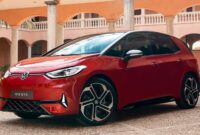Mercedes’ 2022 “Economics of Desire” strategy outlined a shift towards more profitable high-end vehicles. It allocated over 75 percent of R&D funds for products competing in the most profitable market segments, including the “Top-End” cars such as the S-Class, SL, and G-Class, as well as the AMG and Maybach brands. However, Automotive News reports the three-pointed star might be reversing its upmarket push in the United States.
While the rich may get richer, Mercedes allegedly conveyed to dealers at a meeting in Las Vegas this month that 2024 will be the year when the focus shifts to lower-priced cars to drive sales. According to a dealer who attended the meeting, an executive for the German luxury brand stated: “Last year was about profitability; this year is about sales growth.” The plan is to increase the supply of gasoline and hybrid cars, relying on the C-Class and E-Class, along with the equivalent GLC and GLE, to be their bread and butter.

38 Photos
In 2024, Mercedes plans to unveil the replacement for the CLA, although sales in the United States might not commence until 2025. Pictured here is last year’s namesake concept, which, despite being fully electric, can accommodate combustion engines with its Mercedes Modular Architecture. The new family of compact cars will include two crossovers and a shooting brake, already teased as potentially the next-gen GLA, GLB, and CLA Shooting Brake. It’s unclear whether the latter is coming to the United States, though it seems unlikely given that Mercedes isn’t even selling the C-Class wagon here.
Mercedes will also use the upcoming MMA platform for the already teased “Little G” believed to come out in 2026. The new architecture has been developed as “EV-first but not EV-exclusive, and the compromise will rest on the ICE side, not the EV side,” according to a statement made to Motor1 by Christoph Starzynski, Mercedes-Benz vice president of development for electric drive. So much for “the best or nothing” slogan…
In defense of Mercedes, focusing on high-end cars in the aftermath of the coronavirus pandemic made sense. In 2022, supply bottlenecks caused by the lack of semiconductors were prevalent. The company decided to allocate available parts to bigger and more expensive cars that yielded higher profits.
In 2024, as the EV market appears to be cooling down and interest rates are high, prioritizing volume-oriented products is understandable. However, this decision does pose a contradiction to the brand’s intention of moving upmarket. That’s still partially happening since there are plans to simplify the compact car lineup. Models such as the A-Class hatchback, A-Class sedan (which died in the US after the 2022 model year), and the B-Class minivan are likely to be discontinued.
In the US, Mercedes informed dealers at the meeting that no fewer than 25 new and updated models would go on sale in 2024. One dealer representative interviewed by AN was pleased with the change of plan toward cheaper cars, emphasizing that these are easier to sell:
“I’d rather have entry-level vehicles with a turn rate of less than 30 days that I can make a small profit on than carry $100,000 [electric] vehicles for half a year and lose money on.”
The goal for 2024 is to deliver over 300,000 cars in the US where Mercedes sold 282,229 vehicles (excluding vans) in 2023, down by roughly 4,500 units compared to the year before.



